Abstract
The effects on thrombosis and hemostasis of thrombin-induced activation of endogenous protein C (PC) were evaluated in baboons. Thrombosis was induced by placing into arteriovenous shunts a segment of Dacron vascular graft, which generated arterial platelet-rich thrombus, followed by an expansion region of low-shear blood flow, which in turn accumulated fibrin-rich venous-type thrombus. Thrombosis was quantified by 111In-platelet imaging and 125I-fibrinogen accumulation. Intravenous infusion of alpha-thrombin, 1-2 U/kg-min for 1 h, increased baseline activated PC levels (approximately 5 ng/ml) to 250-500 ng/ml (P < 0.01). The lower thrombin dose, which did not deplete circulating platelets, fibrinogen, or PC, reduced arterial graft platelet deposition by 48% (P < 0.05), and platelet and fibrin incorporation into venous-type thrombus by > 85% (P < 0.01). Thrombin infusion prolonged the activated partial thromboplastin clotting time, elevated fibrinopeptide A (FPA), thrombin-antithrombin III complex (T:AT III), and fibrin D-dimer plasma levels (P < 0.01), but did not affect bleeding times. Thrombin's antithrombotic effects were blocked by infusing a monoclonal antibody (HPC-4) which prevented PC activation in vivo, caused shunt occlusion, increased the consumption of platelets and fibrinogen, elevated plasma FPA and T:AT III levels, and reduced factor VIII (but not factor V) procoagulant activity (P < 0.05). We conclude that activated PC is a physiologic inhibitor of thrombosis, and that activation of endogenous PC may represent a novel and effective antithrombotic strategy.
Full text
PDF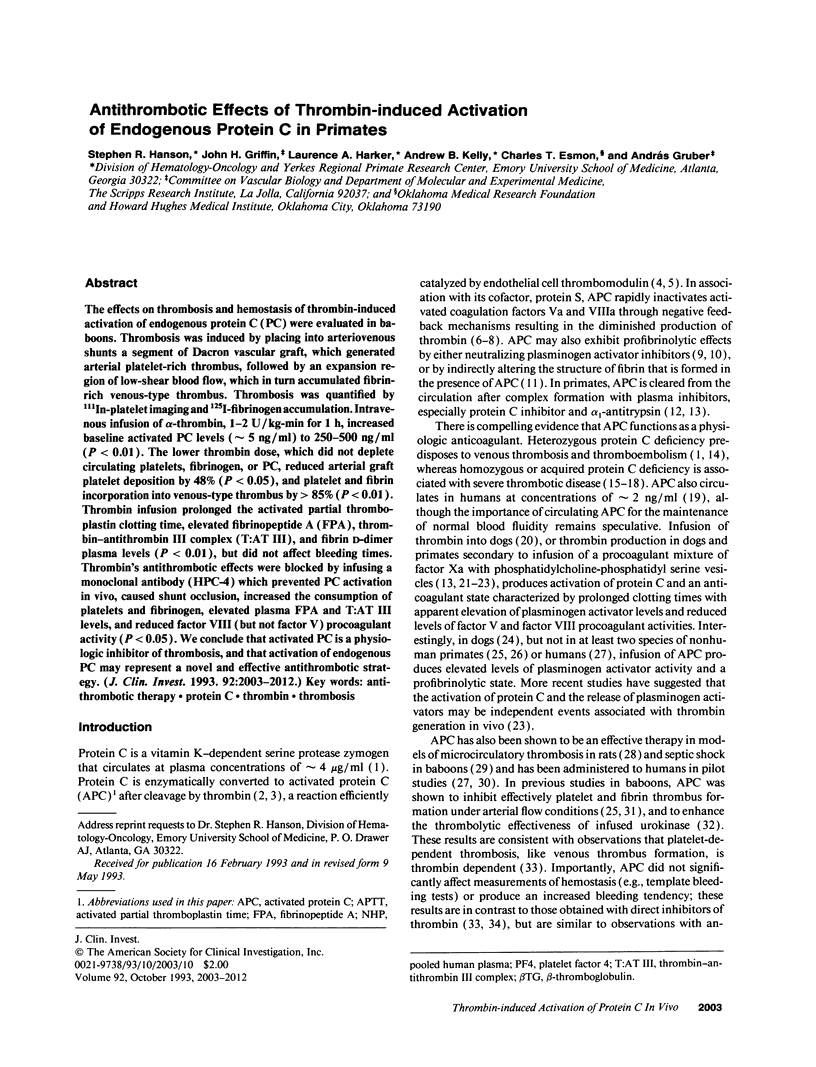
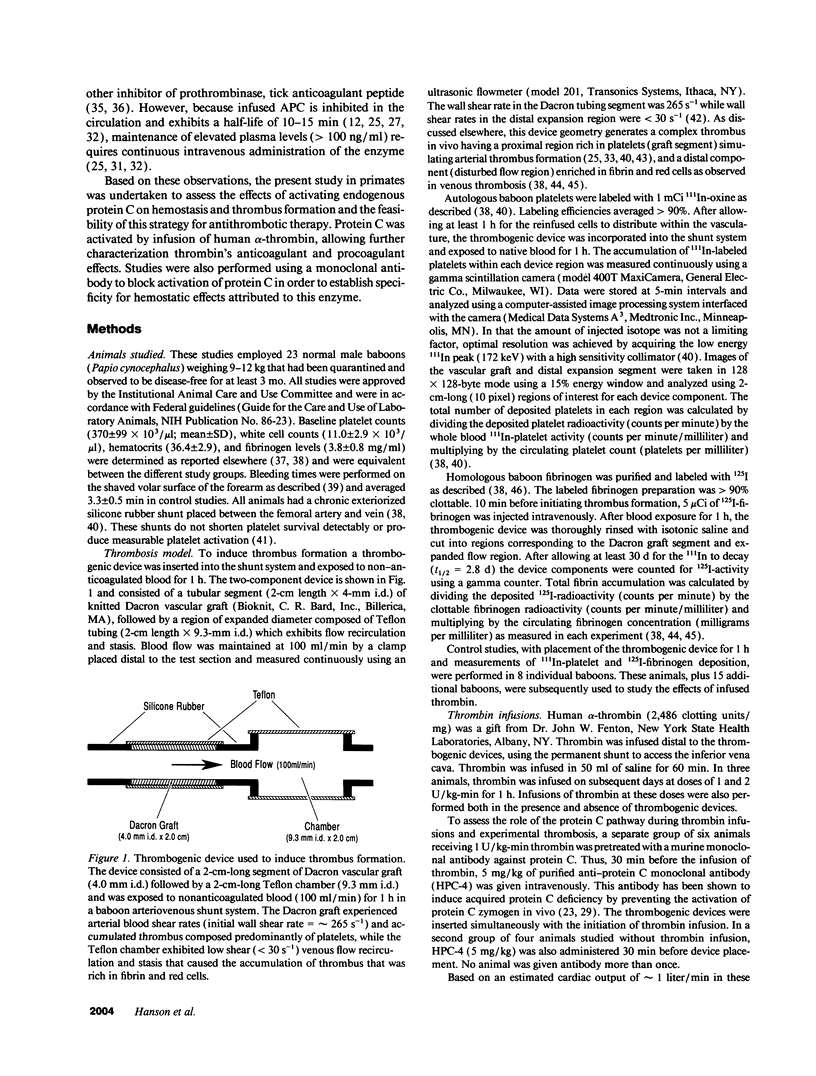
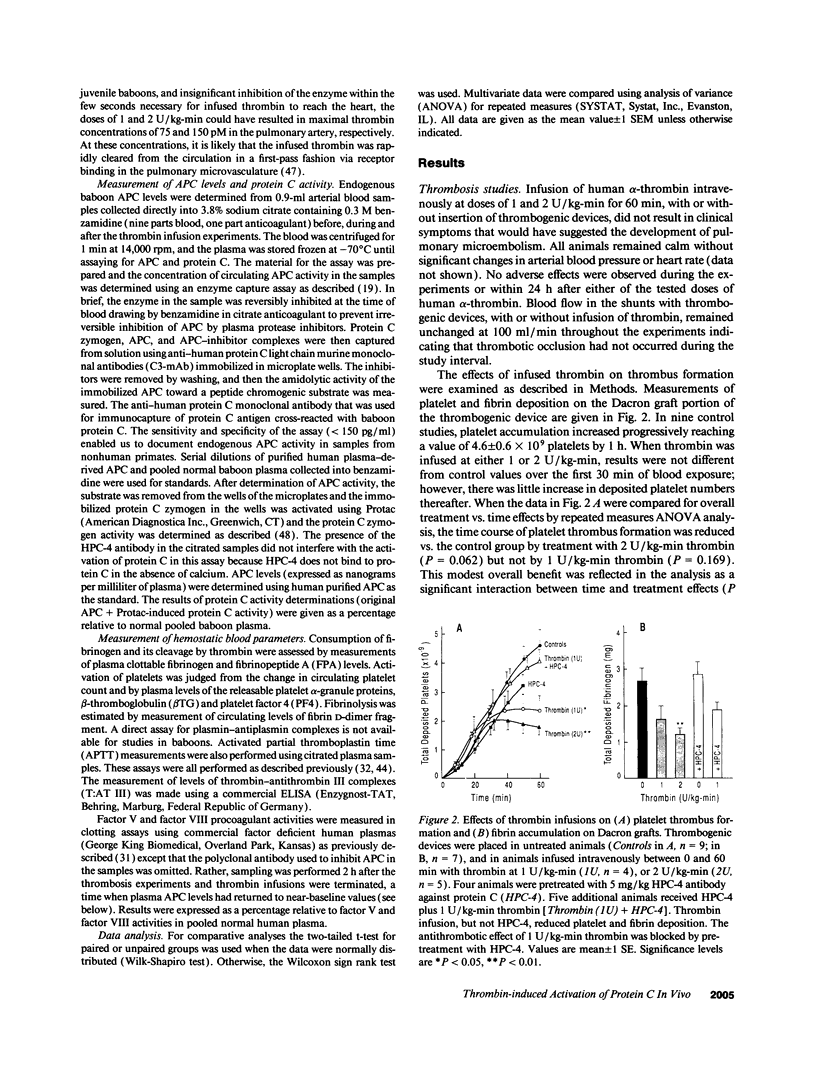
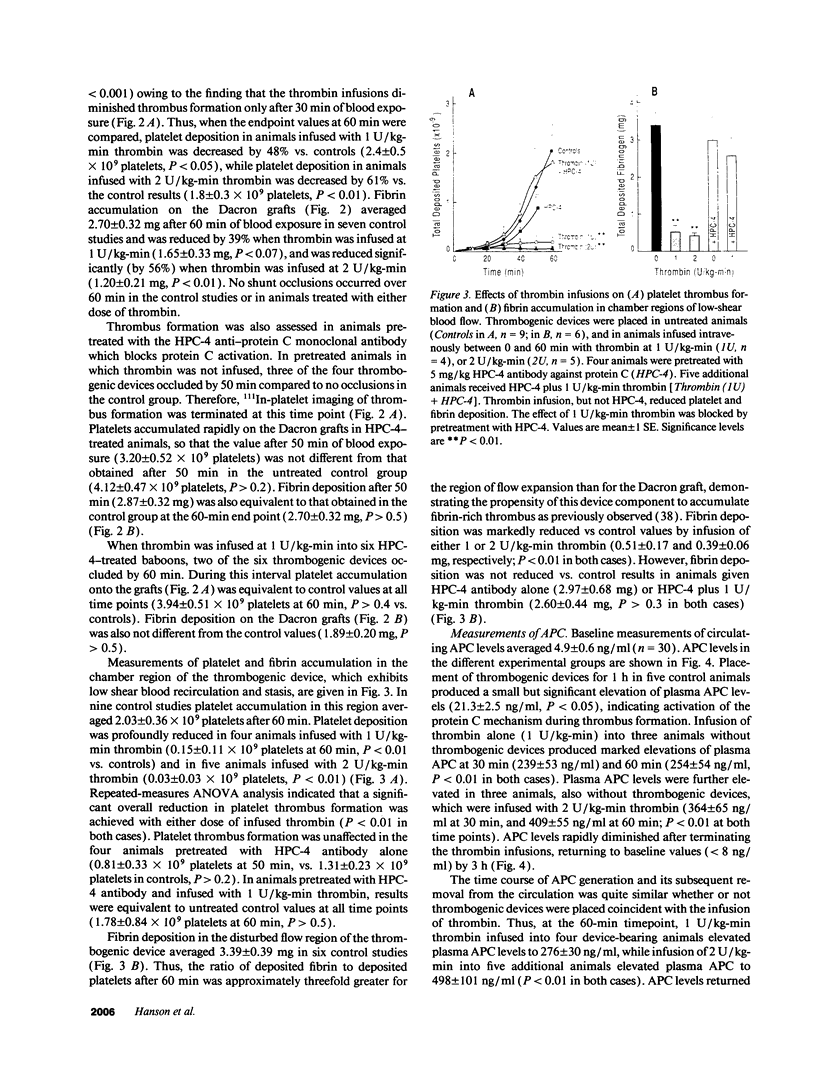
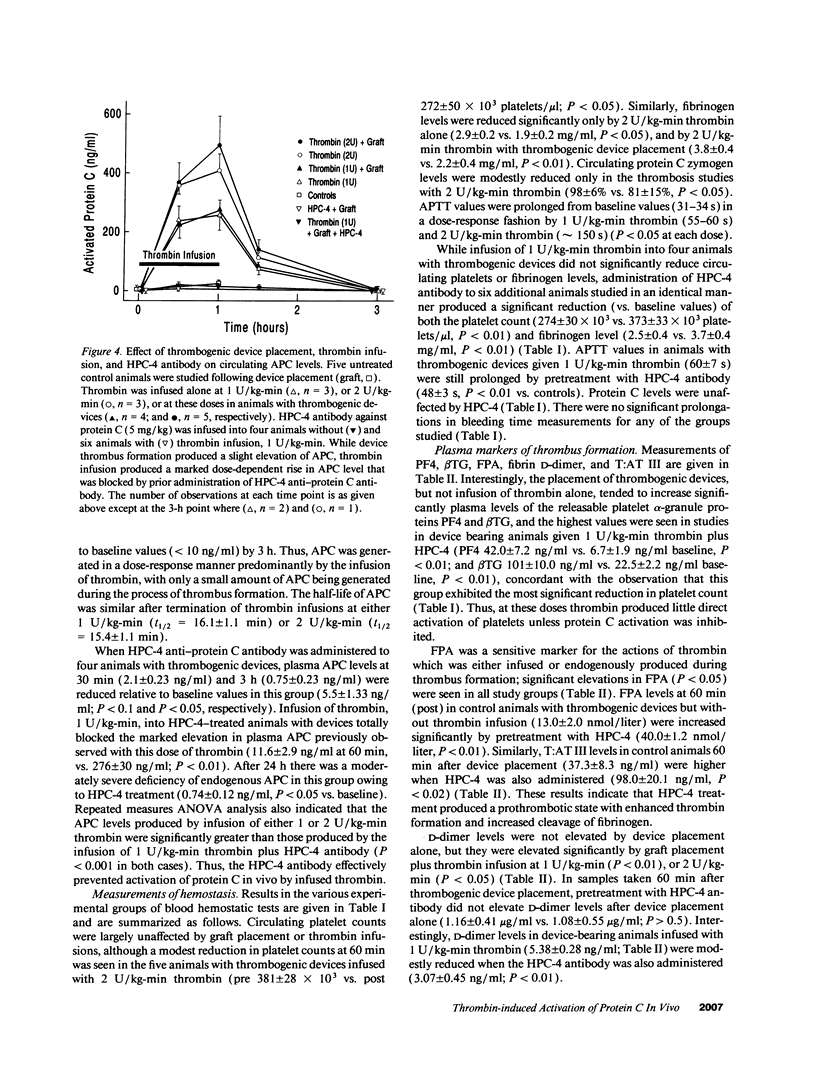
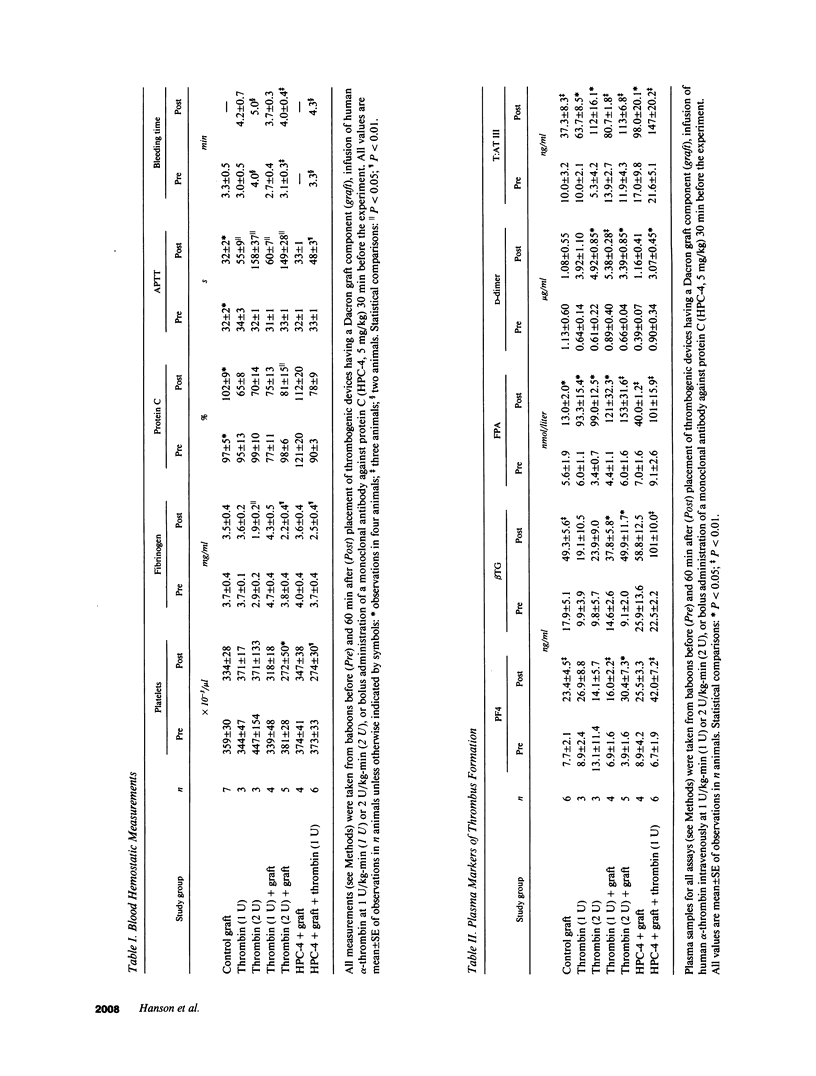
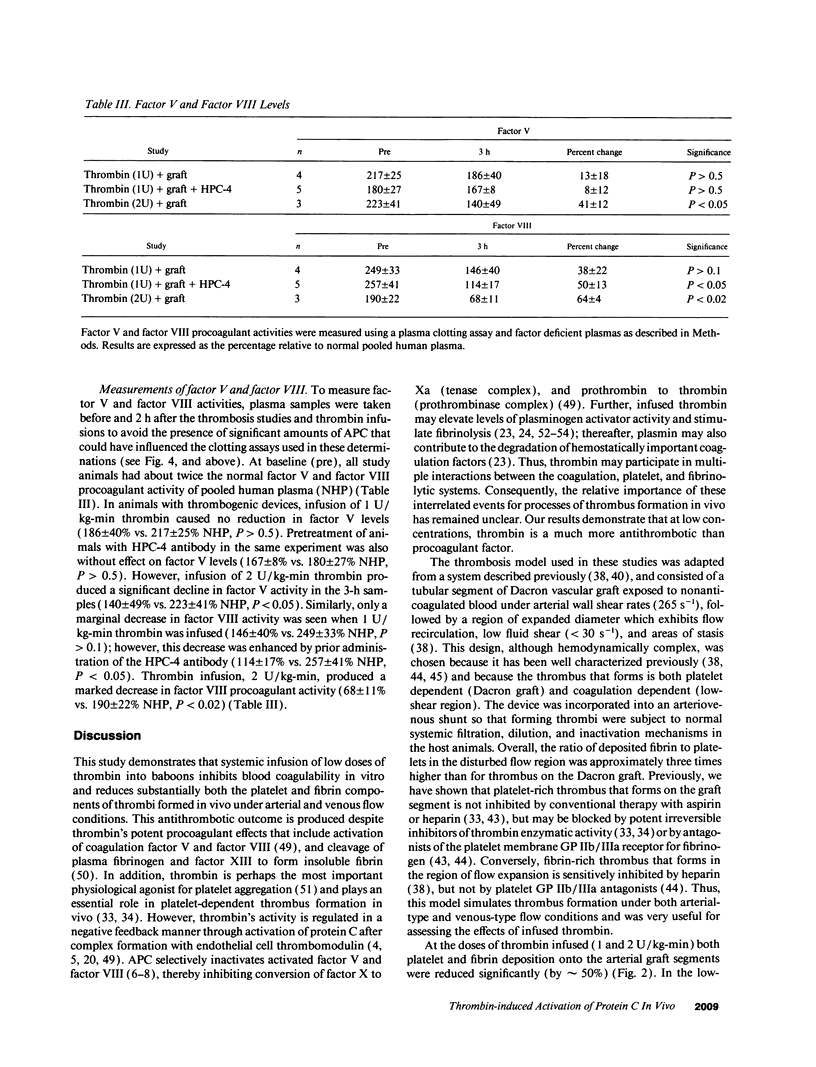
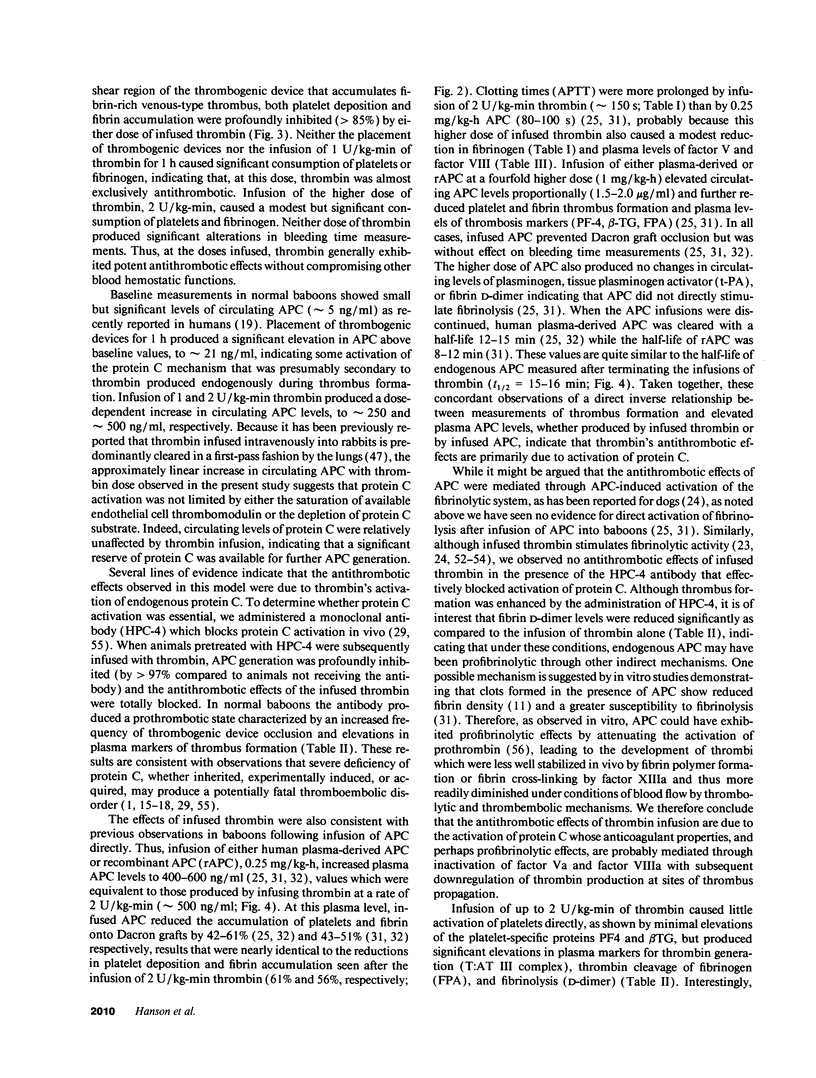
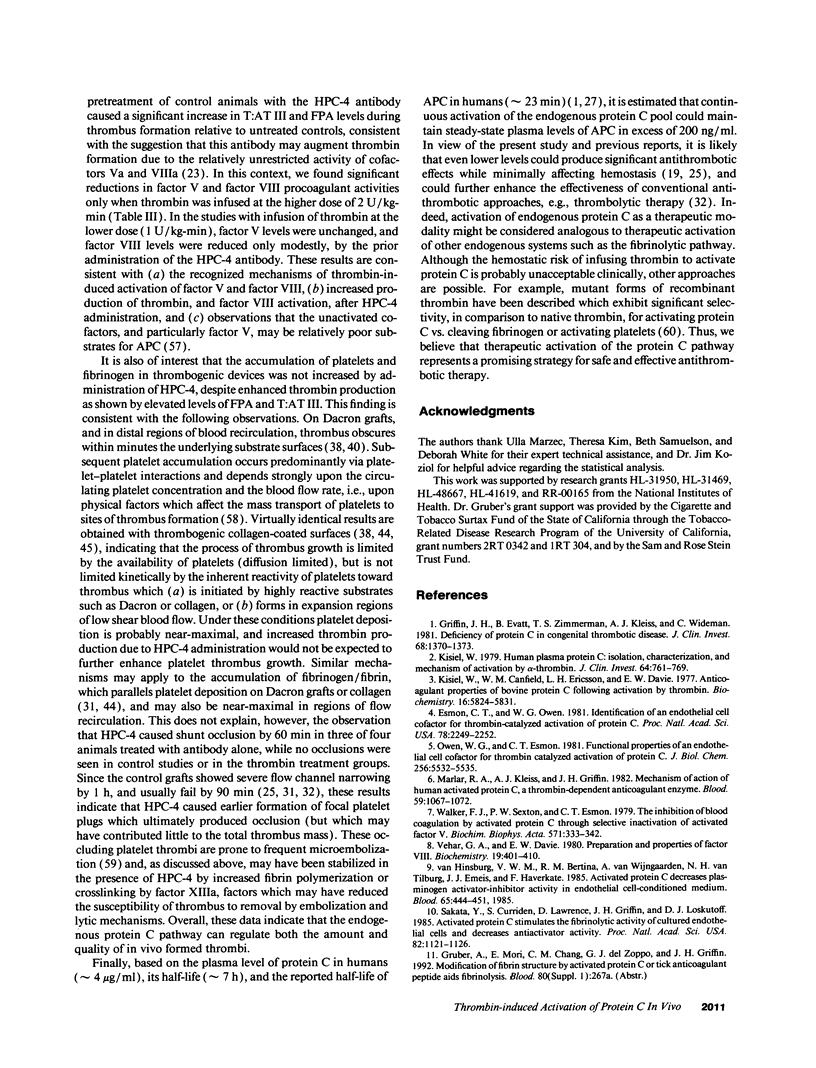
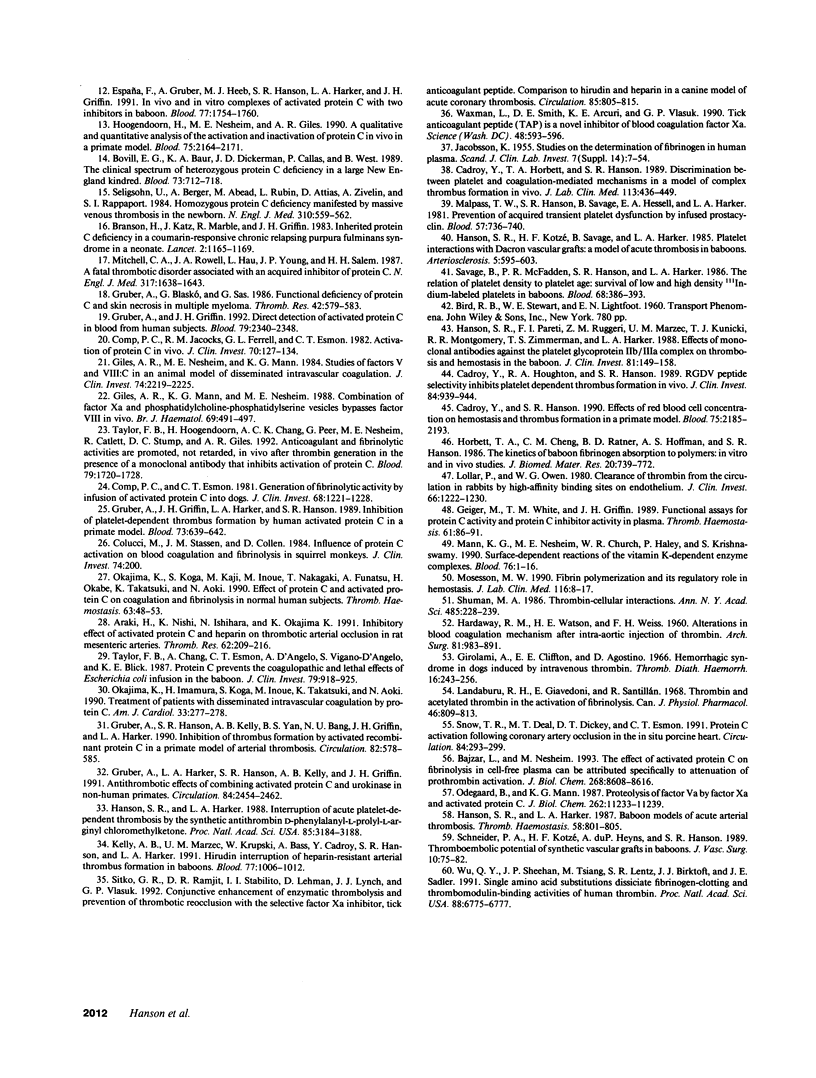
Images in this article
Selected References
These references are in PubMed. This may not be the complete list of references from this article.
- Araki H., Nishi K., Ishihara N., Okajima K. Inhibitory effects of activated protein C and heparin on thrombotic arterial occlusion in rat mesenteric arteries. Thromb Res. 1991 May 1;62(3):209–216. doi: 10.1016/0049-3848(91)90194-2. [DOI] [PubMed] [Google Scholar]
- Bajzar L., Nesheim M. The effect of activated protein C on fibrinolysis in cell-free plasma can be attributed specifically to attenuation of prothrombin activation. J Biol Chem. 1993 Apr 25;268(12):8608–8616. [PubMed] [Google Scholar]
- Bovill E. G., Bauer K. A., Dickerman J. D., Callas P., West B. The clinical spectrum of heterozygous protein C deficiency in a large New England kindred. Blood. 1989 Feb 15;73(3):712–717. [PubMed] [Google Scholar]
- Branson H. E., Katz J., Marble R., Griffin J. H. Inherited protein C deficiency and coumarin-responsive chronic relapsing purpura fulminans in a newborn infant. Lancet. 1983 Nov 19;2(8360):1165–1168. doi: 10.1016/s0140-6736(83)91216-3. [DOI] [PubMed] [Google Scholar]
- Cadroy Y., Hanson S. R. Effects of red blood cell concentration on hemostasis and thrombus formation in a primate model. Blood. 1990 Jun 1;75(11):2185–2193. [PubMed] [Google Scholar]
- Cadroy Y., Horbett T. A., Hanson S. R. Discrimination between platelet-mediated and coagulation-mediated mechanisms in a model of complex thrombus formation in vivo. J Lab Clin Med. 1989 Apr;113(4):436–448. [PubMed] [Google Scholar]
- Cadroy Y., Houghten R. A., Hanson S. R. RGDV peptide selectively inhibits platelet-dependent thrombus formation in vivo. Studies using a baboon model. J Clin Invest. 1989 Sep;84(3):939–944. doi: 10.1172/JCI114256. [DOI] [PMC free article] [PubMed] [Google Scholar]
- Colucci M., Stassen J. M., Collen D. Influence of protein C activation on blood coagulation and fibrinolysis in squirrel monkeys. J Clin Invest. 1984 Jul;74(1):200–204. doi: 10.1172/JCI111402. [DOI] [PMC free article] [PubMed] [Google Scholar]
- Comp P. C., Esmon C. T. Generation of fibrinolytic activity by infusion of activated protein C into dogs. J Clin Invest. 1981 Nov;68(5):1221–1228. doi: 10.1172/JCI110368. [DOI] [PMC free article] [PubMed] [Google Scholar]
- Comp P. C., Jacocks R. M., Ferrell G. L., Esmon C. T. Activation of protein C in vivo. J Clin Invest. 1982 Jul;70(1):127–134. doi: 10.1172/JCI110584. [DOI] [PMC free article] [PubMed] [Google Scholar]
- Esmon C. T., Owen W. G. Identification of an endothelial cell cofactor for thrombin-catalyzed activation of protein C. Proc Natl Acad Sci U S A. 1981 Apr;78(4):2249–2252. doi: 10.1073/pnas.78.4.2249. [DOI] [PMC free article] [PubMed] [Google Scholar]
- España F., Gruber A., Heeb M. J., Hanson S. R., Harker L. A., Griffin J. H. In vivo and in vitro complexes of activated protein C with two inhibitors in baboons. Blood. 1991 Apr 15;77(8):1754–1760. [PubMed] [Google Scholar]
- Geiger M., White T. M., Griffin J. H. Functional assays for protein C activity and protein C inhibitor activity in plasma. Thromb Haemost. 1989 Feb 28;61(1):86–92. [PubMed] [Google Scholar]
- Giles A. R., Mann K. G., Nesheim M. E. A combination of factor Xa and phosphatidylcholine-phosphatidylserine vesicles bypasses factor VIII in vivo. Br J Haematol. 1988 Aug;69(4):491–497. doi: 10.1111/j.1365-2141.1988.tb02405.x. [DOI] [PubMed] [Google Scholar]
- Giles A. R., Nesheim M. E., Mann K. G. Studies of Factors V and VIII:C in an animal model of disseminated intravascular coagulation. J Clin Invest. 1984 Dec;74(6):2219–2225. doi: 10.1172/JCI111648. [DOI] [PMC free article] [PubMed] [Google Scholar]
- Girolami A., Cliffton E. E., Agostino D. Hemorrhagic syndrome in dogs induced by intravenous thrombin. Thromb Diath Haemorrh. 1966 Jul 31;16(1):243–256. [PubMed] [Google Scholar]
- Griffin J. H., Evatt B., Zimmerman T. S., Kleiss A. J., Wideman C. Deficiency of protein C in congenital thrombotic disease. J Clin Invest. 1981 Nov;68(5):1370–1373. doi: 10.1172/JCI110385. [DOI] [PMC free article] [PubMed] [Google Scholar]
- Gruber A., Blaskó G., Sas G. Functional deficiency of protein C and skin necrosis in multiple myeloma. Thromb Res. 1986 May 15;42(4):579–581. doi: 10.1016/0049-3848(86)90221-5. [DOI] [PubMed] [Google Scholar]
- Gruber A., Griffin J. H. Direct detection of activated protein C in blood from human subjects. Blood. 1992 May 1;79(9):2340–2348. [PubMed] [Google Scholar]
- Gruber A., Griffin J. H., Harker L. A., Hanson S. R. Inhibition of platelet-dependent thrombus formation by human activated protein C in a primate model. Blood. 1989 Feb 15;73(3):639–642. [PubMed] [Google Scholar]
- Gruber A., Hanson S. R., Kelly A. B., Yan B. S., Bang N., Griffin J. H., Harker L. A. Inhibition of thrombus formation by activated recombinant protein C in a primate model of arterial thrombosis. Circulation. 1990 Aug;82(2):578–585. doi: 10.1161/01.cir.82.2.578. [DOI] [PubMed] [Google Scholar]
- Gruber A., Harker L. A., Hanson S. R., Kelly A. B., Griffin J. H. Antithrombotic effects of combining activated protein C and urokinase in nonhuman primates. Circulation. 1991 Dec;84(6):2454–2462. doi: 10.1161/01.cir.84.6.2454. [DOI] [PubMed] [Google Scholar]
- HARDAWAY R. M., WATSON H. E., WEISS F. H. Alterations in blood coagulation mechanism after intra-aortic injection of thrombin. Arch Surg. 1960 Dec;81:983–991. doi: 10.1001/archsurg.1960.01300060129025. [DOI] [PubMed] [Google Scholar]
- Hanson S. R., Harker L. A. Baboon models of acute arterial thrombosis. Thromb Haemost. 1987 Oct 28;58(3):801–805. [PubMed] [Google Scholar]
- Hanson S. R., Harker L. A. Interruption of acute platelet-dependent thrombosis by the synthetic antithrombin D-phenylalanyl-L-prolyl-L-arginyl chloromethyl ketone. Proc Natl Acad Sci U S A. 1988 May;85(9):3184–3188. doi: 10.1073/pnas.85.9.3184. [DOI] [PMC free article] [PubMed] [Google Scholar]
- Hanson S. R., Kotze H. F., Savage B., Harker L. A. Platelet interactions with Dacron vascular grafts. A model of acute thrombosis in baboons. Arteriosclerosis. 1985 Nov-Dec;5(6):595–603. doi: 10.1161/01.atv.5.6.595. [DOI] [PubMed] [Google Scholar]
- Hanson S. R., Pareti F. I., Ruggeri Z. M., Marzec U. M., Kunicki T. J., Montgomery R. R., Zimmerman T. S., Harker L. A. Effects of monoclonal antibodies against the platelet glycoprotein IIb/IIIa complex on thrombosis and hemostasis in the baboon. J Clin Invest. 1988 Jan;81(1):149–158. doi: 10.1172/JCI113286. [DOI] [PMC free article] [PubMed] [Google Scholar]
- Hoogendoorn H., Nesheim M. E., Giles A. R. A qualitative and quantitative analysis of the activation and inactivation of protein C in vivo in a primate model. Blood. 1990 Jun 1;75(11):2164–2171. [PubMed] [Google Scholar]
- Horbett T. A., Cheng C. M., Ratner B. D., Hoffman A. S., Hanson S. R. The kinetics of baboon fibrinogen adsorption to polymers: in vitro and in vivo studies. J Biomed Mater Res. 1986 Jul-Aug;20(6):739–772. doi: 10.1002/jbm.820200608. [DOI] [PubMed] [Google Scholar]
- Kelly A. B., Marzec U. M., Krupski W., Bass A., Cadroy Y., Hanson S. R., Harker L. A. Hirudin interruption of heparin-resistant arterial thrombus formation in baboons. Blood. 1991 Mar 1;77(5):1006–1012. [PubMed] [Google Scholar]
- Kisiel W., Canfield W. M., Ericsson L. H., Davie E. W. Anticoagulant properties of bovine plasma protein C following activation by thrombin. Biochemistry. 1977 Dec 27;16(26):5824–5831. doi: 10.1021/bi00645a029. [DOI] [PubMed] [Google Scholar]
- Kisiel W. Human plasma protein C: isolation, characterization, and mechanism of activation by alpha-thrombin. J Clin Invest. 1979 Sep;64(3):761–769. doi: 10.1172/JCI109521. [DOI] [PMC free article] [PubMed] [Google Scholar]
- Landaburu R. H., Giavedoni E., Santillán R. Thrombin and acetylated thrombin in the activation of fibrinolysis. Can J Physiol Pharmacol. 1968 Nov;46(6):809–813. doi: 10.1139/y68-125. [DOI] [PubMed] [Google Scholar]
- Lollar P., Owen W. G. Clearance of thrombin from circulation in rabbits by high-affinity binding sites on endothelium. Possible role in the inactivation of thrombin by antithrombin III. J Clin Invest. 1980 Dec;66(6):1222–1230. doi: 10.1172/JCI109973. [DOI] [PMC free article] [PubMed] [Google Scholar]
- Malpass T. W., Hanson S. R., Savage B., Hessel E. A., 2nd, Harker L. A. Prevention of acquired transient defect in platelet plug formation by infused prostacyclin. Blood. 1981 Apr;57(4):736–740. [PubMed] [Google Scholar]
- Mann K. G., Nesheim M. E., Church W. R., Haley P., Krishnaswamy S. Surface-dependent reactions of the vitamin K-dependent enzyme complexes. Blood. 1990 Jul 1;76(1):1–16. [PubMed] [Google Scholar]
- Marlar R. A., Kleiss A. J., Griffin J. H. Mechanism of action of human activated protein C, a thrombin-dependent anticoagulant enzyme. Blood. 1982 May;59(5):1067–1072. [PubMed] [Google Scholar]
- Mitchell C. A., Rowell J. A., Hau L., Young J. P., Salem H. H. A fatal thrombotic disorder associated with an acquired inhibitor of protein C. N Engl J Med. 1987 Dec 24;317(26):1638–1642. doi: 10.1056/NEJM198712243172606. [DOI] [PubMed] [Google Scholar]
- Mosesson M. W. Fibrin polymerization and its regulatory role in hemostasis. J Lab Clin Med. 1990 Jul;116(1):8–17. [PubMed] [Google Scholar]
- Odegaard B., Mann K. Proteolysis of factor Va by factor Xa and activated protein C. J Biol Chem. 1987 Aug 15;262(23):11233–11238. [PubMed] [Google Scholar]
- Okajima K., Imamura H., Koga S., Inoue M., Takatsuki K., Aoki N. Treatment of patients with disseminated intravascular coagulation by protein C. Am J Hematol. 1990 Apr;33(4):277–278. doi: 10.1002/ajh.2830330413. [DOI] [PubMed] [Google Scholar]
- Okajima K., Koga S., Kaji M., Inoue M., Nakagaki T., Funatsu A., Okabe H., Takatsuki K., Aoki N. Effect of protein C and activated protein C on coagulation and fibrinolysis in normal human subjects. Thromb Haemost. 1990 Feb 19;63(1):48–53. [PubMed] [Google Scholar]
- Owen W. G., Esmon C. T. Functional properties of an endothelial cell cofactor for thrombin-catalyzed activation of protein C. J Biol Chem. 1981 Jun 10;256(11):5532–5535. [PubMed] [Google Scholar]
- Sakata Y., Curriden S., Lawrence D., Griffin J. H., Loskutoff D. J. Activated protein C stimulates the fibrinolytic activity of cultured endothelial cells and decreases antiactivator activity. Proc Natl Acad Sci U S A. 1985 Feb;82(4):1121–1125. doi: 10.1073/pnas.82.4.1121. [DOI] [PMC free article] [PubMed] [Google Scholar]
- Savage B., McFadden P. R., Hanson S. R., Harker L. A. The relation of platelet density to platelet age: survival of low- and high-density 111indium-labeled platelets in baboons. Blood. 1986 Aug;68(2):386–393. [PubMed] [Google Scholar]
- Schneider P. A., Kotzé H. F., Heyns A. D., Hanson S. R. Thromboembolic potential of synthetic vascular grafts in baboons. J Vasc Surg. 1989 Jul;10(1):75–82. [PubMed] [Google Scholar]
- Seligsohn U., Berger A., Abend M., Rubin L., Attias D., Zivelin A., Rapaport S. I. Homozygous protein C deficiency manifested by massive venous thrombosis in the newborn. N Engl J Med. 1984 Mar 1;310(9):559–562. doi: 10.1056/NEJM198403013100904. [DOI] [PubMed] [Google Scholar]
- Shuman M. A. Thrombin-cellular interactions. Ann N Y Acad Sci. 1986;485:228–239. doi: 10.1111/j.1749-6632.1986.tb34585.x. [DOI] [PubMed] [Google Scholar]
- Sitko G. R., Ramjit D. R., Stabilito I. I., Lehman D., Lynch J. J., Vlasuk G. P. Conjunctive enhancement of enzymatic thrombolysis and prevention of thrombotic reocclusion with the selective factor Xa inhibitor, tick anticoagulant peptide. Comparison to hirudin and heparin in a canine model of acute coronary artery thrombosis. Circulation. 1992 Feb;85(2):805–815. doi: 10.1161/01.cir.85.2.805. [DOI] [PubMed] [Google Scholar]
- Snow T. R., Deal M. T., Dickey D. T., Esmon C. T. Protein C activation following coronary artery occlusion in the in situ porcine heart. Circulation. 1991 Jul;84(1):293–299. doi: 10.1161/01.cir.84.1.293. [DOI] [PubMed] [Google Scholar]
- Taylor F. B., Jr, Chang A., Esmon C. T., D'Angelo A., Vigano-D'Angelo S., Blick K. E. Protein C prevents the coagulopathic and lethal effects of Escherichia coli infusion in the baboon. J Clin Invest. 1987 Mar;79(3):918–925. doi: 10.1172/JCI112902. [DOI] [PMC free article] [PubMed] [Google Scholar]
- Taylor F. B., Jr, Hoogendoorn H., Chang A. C., Peer G., Nesheim M. E., Catlett R., Stump D. C., Giles A. R. Anticoagulant and fibrinolytic activities are promoted, not retarded, in vivo after thrombin generation in the presence of a monoclonal antibody that inhibits activation of protein C. Blood. 1992 Apr 1;79(7):1720–1728. [PubMed] [Google Scholar]
- Vehar G. A., Davie E. W. Preparation and properties of bovine factor VIII (antihemophilic factor). Biochemistry. 1980 Feb 5;19(3):401–410. doi: 10.1021/bi00544a001. [DOI] [PubMed] [Google Scholar]
- Walker F. J., Sexton P. W., Esmon C. T. The inhibition of blood coagulation by activated Protein C through the selective inactivation of activated Factor V. Biochim Biophys Acta. 1979 Dec 7;571(2):333–342. doi: 10.1016/0005-2744(79)90103-7. [DOI] [PubMed] [Google Scholar]
- Waxman L., Smith D. E., Arcuri K. E., Vlasuk G. P. Tick anticoagulant peptide (TAP) is a novel inhibitor of blood coagulation factor Xa. Science. 1990 May 4;248(4955):593–596. doi: 10.1126/science.2333510. [DOI] [PubMed] [Google Scholar]
- Wu Q. Y., Sheehan J. P., Tsiang M., Lentz S. R., Birktoft J. J., Sadler J. E. Single amino acid substitutions dissociate fibrinogen-clotting and thrombomodulin-binding activities of human thrombin. Proc Natl Acad Sci U S A. 1991 Aug 1;88(15):6775–6779. doi: 10.1073/pnas.88.15.6775. [DOI] [PMC free article] [PubMed] [Google Scholar]
- van Hinsbergh V. W., Bertina R. M., van Wijngaarden A., van Tilburg N. H., Emeis J. J., Haverkate F. Activated protein C decreases plasminogen activator-inhibitor activity in endothelial cell-conditioned medium. Blood. 1985 Feb;65(2):444–451. [PubMed] [Google Scholar]




